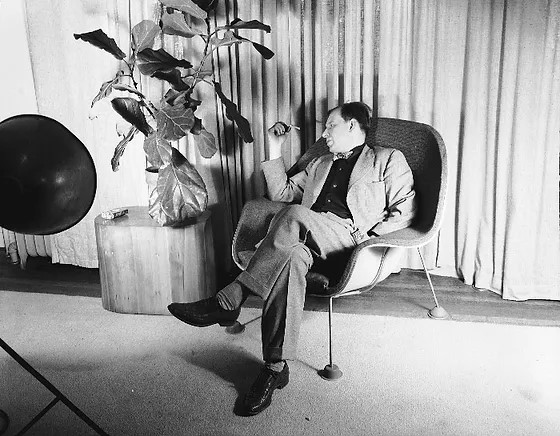A Neo-futurist Designer: Who is Eero Saarinen?
Eero Saarinen, of Finnish-American descent, was one of the most prolific, most distinctive, and most controversial masters of 20th-century architecture. Despite his short career, which ended with his death in 1961 at the age of 51, he remains relevant even today with his modernist designs, from airports to monumental buildings and organically shaped furniture, all of which have become icons.

The son of famous Finnish architect Eliel Saarinen and textile designer Loja Saarinen, Eero immigrated to the United States with his family in 1923. His father, Eliel, settled in Michigan and founded the Cranbrook Academy of Art, taking young Eero with him as an apprentice and becoming the architect of most of the campus buildings.
Eero, who received his architectural education at Cranbrook, would also meet his lifelong collaborator, Charles Eames, here. St. Louis Gateway Arch (1948-64), General Motors Technology Center (1948-56), Detroit and New York's John F Kennedy Airport TWA Terminal (1956-62), which he designed inspired by a winged insect, and Dulles in Washington, DC, where he repeated its organic forms International Airport Terminal took its place among the icons of the 20th century.
Eero Saarinen (August 20, 1910 – September 1, 1961) was a Finnish-American architect and industrial designer who created a wide array of innovative designs for buildings and monuments, including the General Motors Technical Center in Warren, Michigan; the passenger terminal at Dulles International Airport outside Washington, D.C.; the TWA Flight Center (now TWA Hotel) at John F. Kennedy International Airport; and the Gateway Arch in St. Louis. He was the son of Finnish architect Eliel Saarinen.
Saarinen, who designed the furniture of some buildings in Cranbrook even in his youth, had a breaking point in 1940 when he and Charles Eames won the Museum of Modern Art's Organic Design in Home Furnishings competition. Although the molded plywood chairs they made for the competition were not mass-produced, these designs would form the basis of the furniture Saarinen would design for Knoll Associates.
Each of his furniture, which represents exclusivity, mastery, and high imagination in American furniture design, turned into design icons, especially after the war.
He brought a new interpretation to the seat design, which was produced by molding in the 1940s. In the furniture inspired by the shell form, he achieved a monolithic appearance by hiding the molded aluminum structure behind a thin synthetic coating. The Tulip chair, which stands out with its "trumpet" legs, a feature of retro designs, is among the most well-known chair designs. Tulip, which was also used as a seating unit in the Star Trek television series, was produced by the Knoll furniture company founded by Hans Knoll, one of the family friends.
His signature is also on many iconic furniture produced by Knoll, such as the Grasshopper recliner and ottoman (1946), Womb (1948-1950) seating units, and the Pedestal series (1956). Except for the 'Grasshopper' reclining chair, which was not very popular when it was produced in 1965, all these designs still remain up-to-date even today with their forward-looking line.
Saarinen, who created the international image of the American identity in this period defined as the 'American Century', also designed important residence buildings; He used his talent to further modernist ideals such as open-plan architecture, continuity between interior and exterior, and the use of industrial building materials and methods. While Saarinen carried forward his predecessors' understanding of architectural forms arising from new construction technologies, he expanded the vocabulary of modern architecture. He pioneered the modernization of American architectural practice with his buildings and competition themes, many of which he created with his father Eliel Saarinen, and his colleague Cranbrook, in the 1930s and 1940s.
The modernist experiments of the architect, who designed the A Combined Living-Dining Room-Study project for the Architectural Forum in 1937, reached their peak with the Miller House he designed in 1957. Created with a large budget, this house is considered a shining example of Eero Saarinen's holistic environmental research that synthesizes architecture, landscape, and interior design.
Eero Saarinen, who was constantly in search of new construction technologies, was one of the first to realize how valuable architecture was in creating the corporate image of the companies he worked for. Saarinen's firm was the first architectural office to use rust-proof corten steel for its business clients and to build the first curtain wall and design the world's thinnest exterior wall panel.
Saarinen is also the creator of the new office typology and the common campus idea. The General Motors Technical Center in Detroit, completed in 1956, is the first implemented example of this new typology proposed by the architect. His success, which brought him to the cover of Time magazine, paved the way for him to undertake the design and public relations strategies of many companies, from IBM to Bell Laboratories and John Deere & Co.
Eero Saarinen died in Ann Arbor, Michigan USA in 1961.
